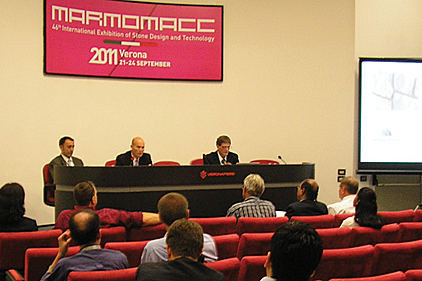To help educate the international stone industry on this project, a session was held during the Marmomacc trade fair in Verona, Italy, where Jack Geibig of Ecoform offered a point-by-point breakdown of its history and objectives.
Benefits of International Stone Standard
• Establish a set of well-defined environmental criteria
• Educate others about stone manufacturing
• Create mechanism for rewarding leadership
• Preempt competitor marketing claims regarding stone
• Harmonize national and international standards for stone
• Facilitate chain of custody reporting for LEED credits
• Create parity with other competitive materials
• Provide opportunity to brand natural stone
Key Elements of a Stone Standard
• Standard which establishes criteria for stone produced in a preferable manner
• Not intended to determine which stone type is better
• Similar to Forest Stewardship Council, would define leadership quarrying and production practices
• Multi-attribute, life-cycle based standard: environmental, human health, social sustainability
• International scope — ISO Process
Key Elements - Development Process
• ANSI-based standard development process
• Multi-stakeholder, open process, public review
•Joint Committee tasked with approving final standard, consensus-based voting process.
• Supplied budget includes:
• Development of standard ($265,000)
• Creation of verification protocol/certification program ($50,000 to $150,000)
• Industry branding and marketing effort led by NSC
• Began in October 2010
•18 to 21 months for standard
• Additional time to establish verification protocol and certification program (three to six months)
Key Organizational Roles
• NSF International - ANSI lead development organization
• Ecoform - Facilitator and standard lead developer
• NSC - Funding organization and stone industry lead organizer
• Members such as the MIA, BSI and ILI are stakeholders and organizer of industry segment participation
• NSF International and Ecoform are the initial certifying organizations
Activities/Milestones
• Stakeholder group formed in September-November 2010
• Joint Committee formed in
January 2011
• Development process underway
• Sub-groups formed around key issues, monthly meetings
• Four in-person workgroup meetings to date
• Certification/verification scheme proposed, details under development
• Draft criteria developed for many key issues; others in-progress
Proposed Certification Scheme
• Quarries and processors certified individually, receive label and listing
• Stone accumulates points for each stage during its production
• Each organization contributes its rating
• Accumulative score achieves Gold, Silver and Bronze tiers
• Stone would be tracked by its chain of custody
Key Scoping Decisions
• Standard will be global in nature, applying to stone both sourced from North America and internationally
• Criteria will focus on meeting North American marketplace demands
• Certification at site level, by organization
• All life-cycle phases will be within scope of standard
• Initial standard will not include stone aggregate, but may consider at later date
• Certification will apply to the stone itself, not the final product
• Certification best applied at quarry, processor and importer/distributor
Categories/Criteria
Stakeholders have developed criteria for each of the following categories:
• Water
• Transportation
• Site Management
• Land Reclamation
• Corporate Governance
• Hazardous Materials
• Energy
• Consumables
• Waste Management
• Human Health and Safety
• Innovation Credits
Draft Criteria - Transportation
Scope: Starts at quarry operations or processing up to the next step (e.g. processing)
Summary of Criteria:
• Inbound/Outbound
•Develop, document and implement technologies and strategies that help carriers save fuel, reduce emissions
•Points awarded for both inbound and outbound transportation strategies
•Scale of points keyed to results
Draft Criteria – Site Management
Scope: Applies to quarries only, on per site basis.
Summary of Criteria:
• Land Maintenance/Ecosystem Conservation
• Site management plan that includes 1. Site cleanliness 2. Minimization of erosion site runoff 3. Establishes/protects ecosystem boundaries, 4. Tracks dust emissions and air quality
• Environmental Assessment
• Conduct an environmental impact assessment during site approval (or after for existing quarries)
Draft Criteria – Corporate Governance
Scope: Applies to all applicant stone organizations
Summary of Criteria:
• Prohibitions on forced labor, child labor (required)
• Anti-discrimination measures (required)
• Employee participation in community building or support events (excludes political activities)
• Company supported community outreach
• Social accountability policies that include:
•Fair hiring practices
•Corporate ethics
•Employee education, etc.
Draft Criteria – Land Reclamation
Scope: Applies to quarries only, on per-site basis.
Summary of Criteria:
• Post-closure land reclamation
• Reclamation plan that includes multiple topics, such as removal of debris, removal/repurpose of buildings, monitoring the site, etc.
•Additional points awarded for adaptive reuse and ongoing maintenance, promotion of bio-diverse ecosystems, etc
Draft Criteria – Water
Scope: Applies to quarries and stone processors
Summary of Criteria:
• Complete a water inventory (required)
• Recycled water 50% (required), additional points for higher recycle rates
• Water reduction/use efficiency
program that rewards beyond compliance water use and treat
• Impact adjusted water usage
• Water quality of discharge, scaled to reward quality of discharge
• Responsible use of gray water earns a point
Draft Criteria – Energy
Scope: Applies to quarries and stone processors
Summary of Criteria:
• Operations energy use; rewards Energy Star or equivalent program
• Employee commuting/travel
• Equipment operation and maintenance plan
• Energy sources including:
Fuels: rewards life-cycle analysis and implementation of alternative fuels
•Electricity: rewards carbon offsets as well as alternative fuel analysis and implementation
• Measurement and continuous improvement
•Tiered awards for carbon footprinting and measured improvement
Development Issues - Summary
• How to best define clear boundaries around quarrying and processing?
• Relevance of scrap rate and quarry yield, and how to drive improvement?
• How best to capture life-cycle of stone in criteria, (e.g. scrap stone)?
• How to translate North American-based criteria to stone companies outside the U.S.?
• Which criteria are required versus optional, and how to weight them in overall scheme?
• What is manifestation of certification at point of sale?
• How best to implement chain of custody tracking of stone?
Upcoming Development Schedule
• December 30, 2011 — Weighting of criteria in standard complete
• January 24, 2012 — Draft standard for stakeholder review
• February 28, 2012 — Comment period ends
• Second Quarter 2012 — Final standard released
Compliance/Verification Program
• Ecoform to develop robust verification plan
• “Genuine Stone” branded label
• Authorize select independent
certifying organizations
• Only authorized bodies can bestow “Genuine Stone” label
• Negotiate fee for certification
To Participate
• Serve as a stakeholder - Contact Ecoform - jgeibig@ecoform.com
• Receive and review project documents, provide comments
• Join the Joint Committee
• Complete an application
• Attend majority of meetings
• Provide Financial Support
Contact NSC directly at www.naturalstonecouncil.org




